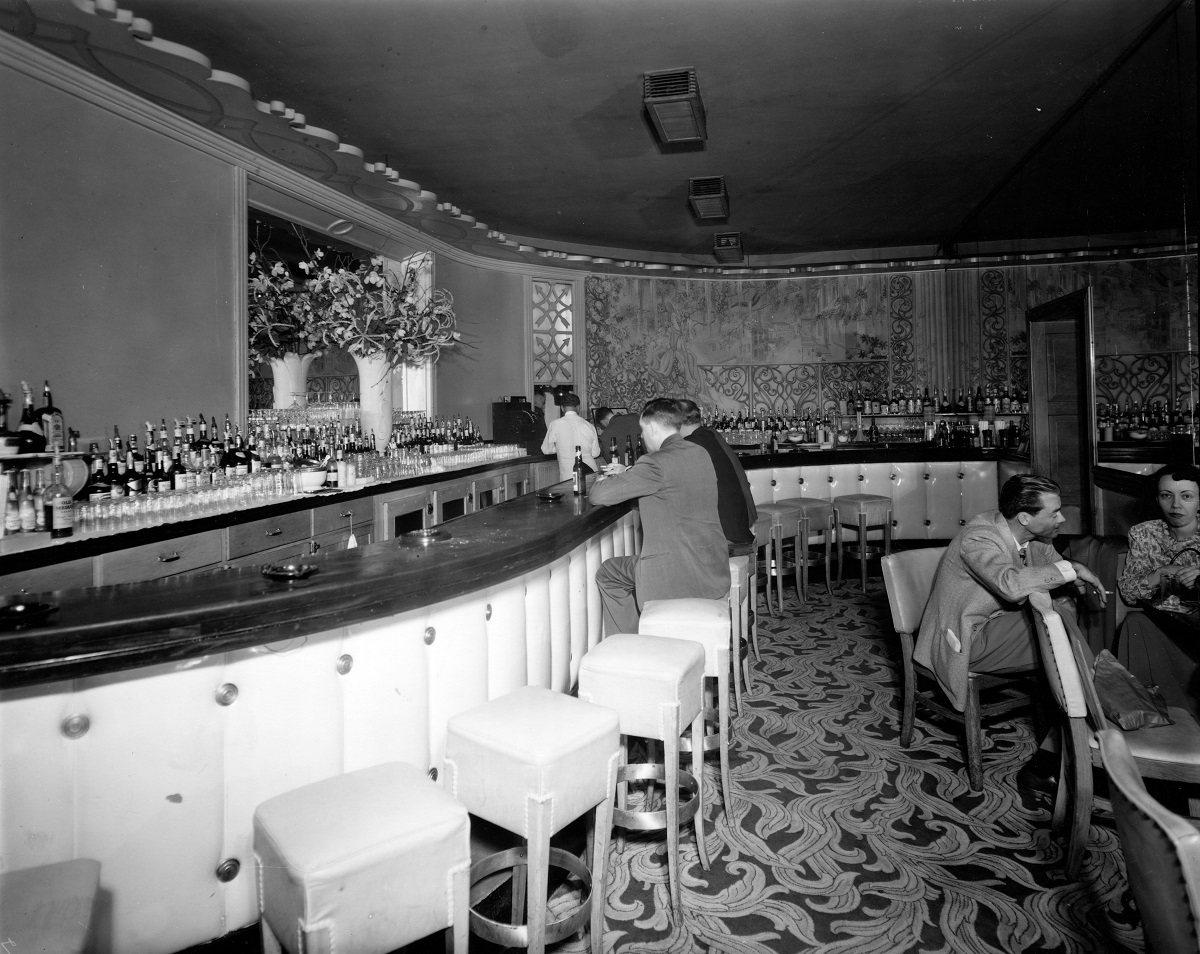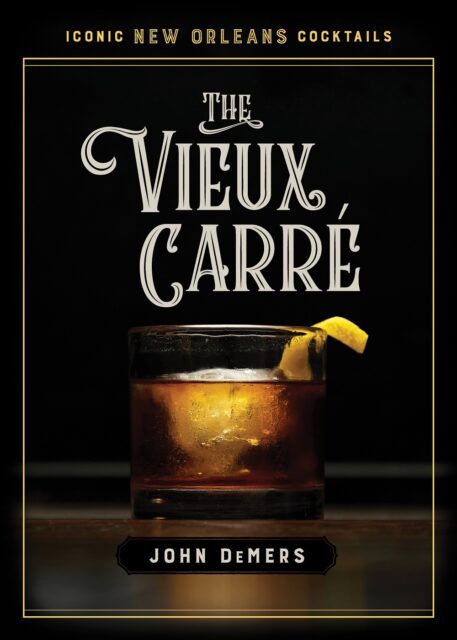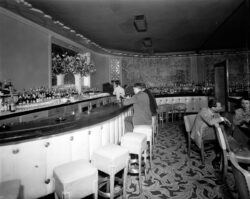Magazine
An Invention You Can Pour
An excerpt from The Vieux Carré by John DeMers
Published: May 31, 2023
Last Updated: August 31, 2023

Charles L. Franck Studio Collection, The Historic New Orleans Collection
Lobby Bar, Hotel Monteleone.
Robert Fulton, Eli Whitney, Thomas Edison, Alexander Graham Bell, Guglielmo Marconi—all names of great inventors who changed the way we live for a time or forever. But not every gifted inventor’s name is known to us, and, even around the New Orleans French Quarter, you’d have to skim for a while to come across the name Walter Bergeron. Bergeron was a bartender, you see. A man who fixed cocktails for customers in the bar of a legendary New Orleans hotel. His invention is a thing that’s consumed—and typically good to the last drop. . . .
Walter Bergeron would name his cocktail after the traditional French section of the town where he lived—the Vieux Carré. And he would strive to include in his invention five products from five different parts of the world that contributed to making his city unique. As he was working in the French Quarter, he made certain to include French components, from the world-famous brandy produced in (and named for) the region of Cognac to the liqueur known as Bénédictine. During Bergeron’s active years, the French Quarter was also home to a vibrant population from Italy, including many immigrants from Sicily, Calabria, and the rest of the impoverished south. He paid tribute to their many contributions (led off, naturally, by the Hotel Monteleone itself) by including sweet vermouth, a taste beloved in classic, now-rediscovered Italian drinks like the Negroni. Then, too, since the beginning of the twentieth century, some of the forces at play in New Orleans had come from the “American side” of Canal Street, giving the old French Creole families a literal run for their money. These newer arrivals from the interior of America had probably acquired a taste for whiskey, be it from Kentucky, Tennessee, or much farther north in Canada. Rye was often their spirit of choice, so rye went into the Vieux Carré as well. Quite a few pre-Prohibition cocktails drew complexity from one ingredient known as “bitters,” so Bergeron for some reason decided he liked what happened when he added two kinds of bitters. Both products had roots in the Caribbean, an area with long, sad links to the slave trade but also to embracing the port of New Orleans as its doorway to the entire United States. . . .
For the most part, we don’t memorialize bartenders as inventors, but perhaps we should. Whether it’s a new recipe for a cocktail or a welcoming smile on a chilly, rainy night, or maybe a piece of an overheard anecdote that cheers us, bartenders are inventors. Yet because their inventions are consumed, we don’t necessarily remember the names of their creators, much less write them down for posterity. Each time we hear the name Walter Bergeron around the neighborhood the French settlers took to calling Vieux Carré (Old Square), we realize again that the drink he crafted at the Hotel Monteleone is actually a big deal.
In creating the Vieux Carré, Walter Bergeron was trying to pay tribute in the best way he knew how to the melting-pot cultures that created the New Orleans he knew and loved. Though some of the history may be less familiar to us now, Bergeron couldn’t have painted his adopted city any better had he wielded a brush at an easel with a palette splattered with paints around Jackson Square—instead of a shot glass and a cocktail shaker in one of the Crescent City’s most beloved and historic hotels.
The Sazerac may have been the earliest local cocktail to gain a following, and the Ramos Gin Fizz may have accumulated the most political clout, both in Louisiana and later Washington, DC—but only the Vieux Carré cocktail is able to subtitle its calling card: The Flavors That Made New Orleans.
Vieux Carré
Drinkers of the analytical sort have noted the impressive balance of flavors in the original Vieux Carré recipe created at the Monteleone by Walter Bergeron. Still, at its heart, the drink is a balancing act among the sweet, the not-so-sweet, and the bitterly botanical. Most drink recipes, of course, would call for one of arguably the two best-known brands of bitters. The Vieux Carré calls for both. As with cooking a dish for dinner at home, there is always some wiggle room to account for personal taste. Here is the classic recipe.
1 ounce rye whiskey
1 ounce cognac
1 ounce sweet vermouth
¼ ounce Bénédictine
2 dashes Peychaud’s bitters
2 dashes Angostura bitters
Lemon peel for garnish
Add all the ingredients to a mixing glass, add ice cubes, and stir. Strain the cocktail into a rocks glass with fresh ice. Garnish with a lemon peel.

LSU Press.
EXCERPT FROM:
The Vieux Carré
by John DeMers
$19.95; 116 pp.
Louisiana State University Press
February 2023

